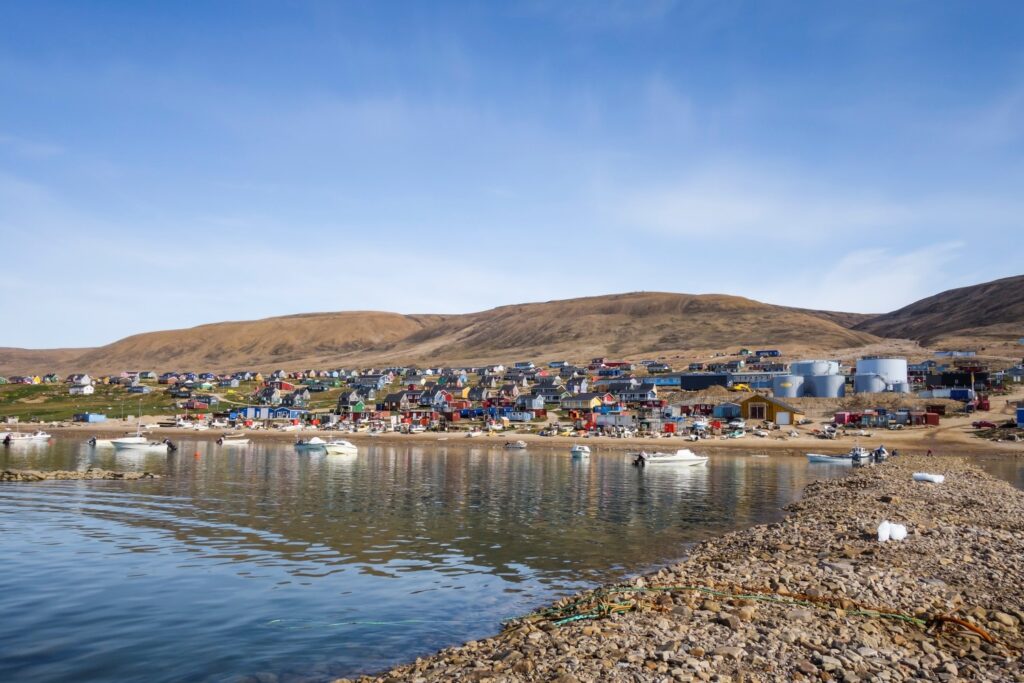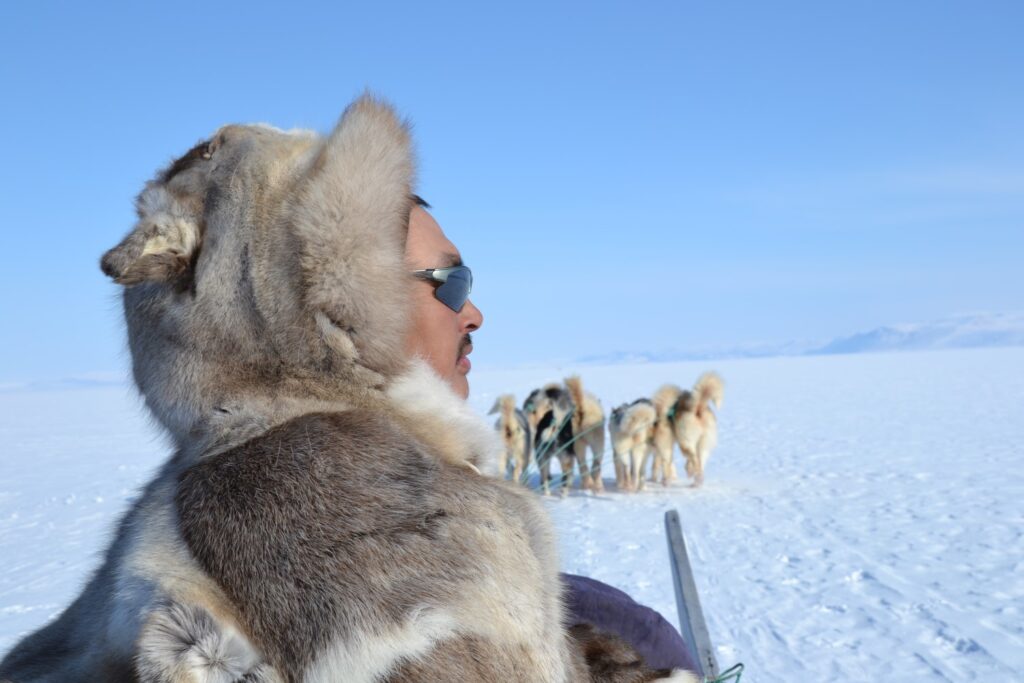

KIM INSUK/VISIT GREENLAND, 2019
Qaanaaq is the current Greenlandic name for Thule and means ‘caves by the beach’. Qaanaaq is Greenland’s youngest and northernmost town with 619 inhabitants (2021). The town was established by the Danish State in 1953 after the relocation of the population from what was then Thule, which was called Uummannaq in Greenlandic. Thule had been named after the trading station established by Knud Rasmussen and Peter Freuchen in 1910 – a name inspired by the Antiquity designation of a happy island at the northernmost end of the world.
During the majority of the year when there is ice on the fjord, the Qaanaaq area has continental climate with extremely little precipitation – also known as High Arctic desert.
History of Qaanaaq

KÅRE HENDRIKSEN, 2015

GRØNLANDS STATISTIK
The population north of Qimusseriarsuaq (Melville Bay) is a later immigration from Canada than the other Inuit, and they define themselves as Inughuit, having their own language (dialect) and a distinct hunting culture. For example, Inughuit are the only ones in Greenland who lived in igloos on their hunting trips. Inughuit were formerly called Polar Eskimos by Europeans.
The population lived in isolation from the rest of Greenland with only sporadic contact with Inuit in the northern part of Upernavik district, and from the early 19th century, visits by single expeditions. Beginning in 1886, American Robert Peary conducted several expeditions in the area. This caused concern that the United States would lay claim to northernmost Greenland – and it became a contributing reason for The Literary Expedition by sled across Qimusseriarsuaq (Melville Bay) from 1903 to 1904. The Thule trading station at the Uummannaq settlement was established in 1910 to secure supplies for the population – and to ensure that the area became Danish. The trading station became the starting point for Knud Rasmussen’s Thule expeditions, and Northwest Greenland north of Qimusseriarsuaq was named Thule in Danish.
Thule and the Thule expeditions had great importance in the inter-war period for Danish self-understanding, but despite several attempts, the running of the trading station was not taken over by the state until 1937, and the district was not given the same status as the old colonies; for example, Thule did not get status of a municipality but instead a Hunters’ Council was established.
In 1951, the United States established Thule Air Base (Pituffik) on the great plain a few kilometres east of the Uummannaq settlement, and wanted to expand at the settlement in 1953. In May 1953, while it was still Arctic winter, Danish officials told the 116 Inughuit (27 families) to leave the area with few days’ notice, and said that they would be given new houses at Qaanaaq. Therefore, 13 families travelled the 120 km north to Qaanaaq by dog sleds, while the other families travelled to other settlements in the district.
With the new Danish Constitutional Act of 5 June 1953, Greenland formally became an equal part of the Danish kingdom. It has later been discussed whether the reason for the hasty relocation was the desire not to clash with the Danish Constitutional Act.
Development and geography of Qaanaaq
On arrival in Qaanaaq, there was nothing. It was not until July, when it was possible to transport materials and workmen by ship, that a frantic establishment of the new Thule started, which was designated as the district’s new centre.
The small replacement houses of between 14 and 24 m² built for the Inughuit along the beach were not finished until September, when winter had set in – until then the families lived in tents. In the summer of 1954, the ‘Danish town’ with the necessary infrastructure, such as school, shop, telegraph station, etc., as well as dwellings for the Danish officials and their families were established along the main road perpendicular to the coast. The official residences in the Danish town were considerably larger and, as the first in Greenland, they were provided with district heating, while the replacement houses had coke stoves. Roughly speaking, the town has retained its structure with the community infrastructure gathered east of the river, while most of the development was seen west of the river.
Qaanaaq lies on a moraine slope with permafrost by a river in which water runs during the four summer months but is otherwise dry. In summer, two large water tanks are filled with river water for the winter, but this far from covers the need. Therefore, ice from icebergs is harvested on the sea ice with a dumper truck and wheel loader, and the ice is melted in a smelter. With climate change and thinner sea ice, this task becomes more dangerous and is at the same time extremely costly with a production price of around DKK 700 per cubic metre of water. Therefore, for the storage of river water, another water tank has been established, which was finished in the autumn of 2021.
The town has no sewer for black water, and the entire town, including the hospital, uses toilet buckets and collection of latrines. In the eastern part of the town, there are two parallel sewer lines for grey water. Both lines start at the hospital. Only the easternmost part, including the school, is connected and is today fully operational after a renovation in 2021. In the remaining part of town, the grey water is discharged to the ground, where in winter it creates ice formation at the foot of the houses.
Off the town is a reef that protects the coastline from swells, but also means that everything has to be barged in and out as there is no draught to a port. To smooth the barging, a pier was established to the reef in 2020.
The town is founded on permafrost, and this presents major challenges that are accelerating with climate change. Many of the houses, particularly west of the river, have suffered considerable subsidence damage, some even to such an extent that they are uninhabitable. This is a contributory cause of the town’s major housing shortage, with many young people having to stay with their parents in small houses, even after they have had children themselves.
The sea ice, which is seen most of the year, obstructs shipping and navigation, so Qaanaaq and the district’s three settlements receive only two annual supply ships in July and early September, respectively.
In 2001, a gravel runway was established about 7 km west of the town to ensure better connection to the rest of Greenland. Until then, the only connection was helicopter service to Pituffik (Thule Air Base) and aircraft from there, implying some limitations and requiring a permit by the US military. On the other hand, back then the airfare to the country’s traffic hub Kangerlussuaq was considerably cheaper than now, where, for example, a return flight to Nuuk costs around DKK 18,500 and requires an overnight stay each way. In summer, the road between the town and the airport is sometimes washed away during heavy thaw and rainstorms.
Business base of Qaanaaq
Since its establishment, the town has grown and its population peaked in 2011 at 678. The population has since decreased slightly, partly because some administrative jobs moved to Ilulissat following the municipal amalgamation in 2009.
The main industry – or the one that employed the most men – was until the beginning of the new millennium hunting of marine mammals such as seal, walrus, narwhal and beluga whale, as well as muskox, caribou, polar bears and birds. But conservation regulations have limited hunting, and the CITES regulation has reduced opportunities for the export of skins and tusks while the population has increased. It has reduced the income opportunities of the hunters. However, hunting remains an essential part of the business base for several families and contributes greatly to the town’s food supply. The district has about 75 registered commercial hunters.
A small fish factory was established in Qaanaaq in the late 1980s, and since then there has been increasing longline fishing of Greenland halibut from the sea ice. This gives some hunters a monetary supplement. The factory has been expanded several times and is today operated in partnership between Royal Greenland and local company Inughuit Seafood. In winter, during the fishing season, there are about 12 jobs at the factory.
Furthermore, there are about 55 municipal jobs and 40 jobs in the government-owned infrastructure companies in the town and the three settlements of the district, to which should be added a carpentry company and a plumbing company with up to 15 employees during the season, as well as a small hotel and occasionally a kiosk and corresponding small businesses. Including the hunters, this means that there are about 230 jobs in the district with 474 (2021) people of working age.
Overall, Qaanaaq is the poorest district in Greenland with the lowest average household income, while average social benefits do not reflect the fact that such a large proportion of the population is outside the labour market, which can be attributed to hunting and its importance for subsistence economy.
Tourism
Qaanaaq district with the beautiful High Arctic scenery holds unique tourism development potentials that cater to a growing international segment. Summer allows for kayaking trips together with experienced hunters who still hunt narwhals from their kayaks, as well as longer sailing trips possibly combined with seal hunting and caribou hunting. The period of ice cover, which continues right through mid-July, offers long sled trips in the glow of the midnight sun. Several hunters offer sled hunting trips of up to several weeks with overnight stays in a tent, or the opportunity to participate in the longline fishing of Greenland halibut from the sea ice.
Despite the extremely high fares, Qaanaaq is visited by ever more tourists who want unique nature and cultural experiences. Combined with the development of the fishing industry, tourism can help develop and ensure a business base and livelihood for the Inughuit – the world’s northernmost indigenous population group.

ASIAQ, 2022
Further reading
- Avannaata Kommunia
- Education
- Ilulissat
- Industry and labour market
- Infrastructure
- Inuit hunting culture
- Towns and settlements
- Upernavik
- Uummannaq
Read more about the Municipalities and towns in Greenland
